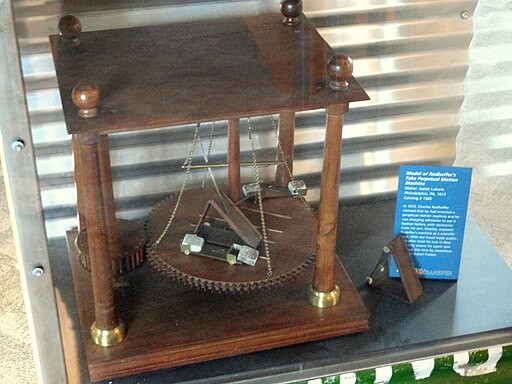Just like living things, all machines require energy to do work. While organisms get energy from the food they eat, machines obtain it from sources such as fuel. As more machines are invented to perform more complex tasks, they must also be sustained by enough energy supply. For this reason, scientists consider the possibility of creating a perpetual motion machine that makes and does not use up energy.

(Photo: Wikimedia Commons/ Daderot)
What is a Perpetual Motion Machine?
A perpetual motion machine is a device that can run indefinitely without the need for an external source of energy to power it. It is designed to reinvest in itself the energy it produces to keep moving. Once it starts, it runs forever while providing free energy.
The perpetual motion machine is an inventor's dream. If anyone figures out how to make it work, we can get something for nothing, which means we can generate energy without spending any energy.
READ ALSO: Robot Revolution: Machines to Do 50% of Work Tasks by 2025
Law-Breaking Machine
Attempts to build a perpetual motion machine go back to the 12th century. In 1159, an Indian astronomer and mathematician named Bhaskara the Learned invented a wheel with curved reservoirs filled with mercury. The mercury was expected to flow to one end and make it heavier than the other side, allowing the wheel to move forever without the supply of an external force. Bhaskara's wheel inspired different designs of perpetual motion machines.
In the 17th century, Irish chemist and physicist Robert Boyle also proposed a perpetual motion machine. His design involves a flask that freely replenishes water through a siphon. The structure of the flask and its siphon are meant to make water flow forever. Unfortunately, this attempt at creating a perpetual motion machine did not work.
Every attempt at making perpetual motion machines has failed, and they likely will never work as their inventors hoped. The problem is that all these attempts violate a crucial law of physics: the principle of thermodynamics. This law describes the relationship between different forms of energy.
The first law of thermodynamics, also known as the law of conservation of energy, states that energy cannot be created or destroyed but can only be transformed from one form to another. For a machine to keep going, the energy applied must stay with it without any losses. A perpetual motion machine violates the first law of thermodynamics because it would have to produce work without energy input.
Meanwhile, the second law of thermodynamics states that an isolated system will move toward a state of disorder. It also explains that the more energy is transformed, the more it is wasted. A perpetual motion machine would need energy that was never wasted and never moved toward a disordered state.
Theoretically, building a perpetual motion machine requires accomplishing many things. For example, there should be no rubbing parts to prevent creating friction, which causes the machine to lose its energy to heat. Moreover, the machine would have to work inside a vacuum because operating it anywhere else would result in energy loss due to air friction. Since sound is also a form of energy, a perpetual motion machine would have to produce no sound.
RELATED ARTICLE: Scientists Create Living, Eating, Growing Machines
Check out more news and information on Machine in Science Times.










!['Cosmic Glitch' in Einstein's Theory of General Relativity Could Be Explained in This New Scientific Tweak [Study]](https://1721181113.rsc.cdn77.org/data/thumbs/full/53435/258/146/50/40/cosmic-glitch-in-einsteins-theory-of-general-relativity-could-be-explained-in-this-new-scientific-tweak-study.jpeg)



